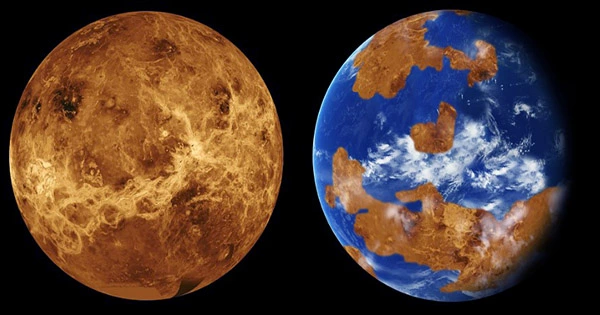Venus is the only planet orbiting the Sun that has a day that is longer than its year – that is, it rotates so slowly on its axis that it takes longer to revolve on its axis than it does to orbit the Sun. This odd activity is most likely due to its dense atmosphere, an instance of the planetary dog’s tail wagging. Even while this is unusual inside the Solar System, it might be extremely prevalent beyond. Many of the moons in the Solar System, including our own, have a rotation period that corresponds to their orbit, leading them to constantly face their planet. Planets in tight orbits are subject to the same forces that cause “tidal locking.”
Mercury was formerly assumed to be tidally bound to the Sun, with one side blazing hot and the other cooled by gazing forth forever towards the stars. According to Professor Stephen Kane of the University of California, Riverside, Venus was on the verge of having two such diametrically opposed sides, and only its thick atmosphere saved it. Kane discusses his argument in Nature Astronomy, as well as the ramifications for newly found planets.
The year on Venus is 225 Earth days long, yet the planet rotates in 243 days. However, not everything moves at a snail’s pace there. The winds on Venus are so strong that it takes fewer than four days for the whole atmosphere to complete a circuit of the planet, which is caused by thermal imbalances between day and night. They pull on the planet’s rough surface, slowing the planet’s already sluggish rotation even more, and Kane believes this is why the two periods don’t match. In a statement, Kane said, “We think of the atmosphere as a thin, nearly distinct layer on top of a planet that has limited contact with the actual globe.”
“Venus’ tremendous atmosphere shows us that it’s a lot more integrated aspect of the planet that influences everything, even the planet’s rotation speed.” Venus’s thick atmosphere, nearly entirely composed of carbon dioxide, is most known for successfully absorbing the Sun’s heat, making the planet hotter than Mercury and baffling science fiction writers who anticipated a humid but bearable environment. Kane wonders if these two impacts are connected: has Venus’s day length led to its excessive average heat and shift away from habitability? The answer might have far-reaching ramifications for what we could find on rocky planets orbiting toward the inner reaches of stars’ presumed habitable zones.
With so many planets discovered close to their stars, scientists must decide which are the most important to investigate with limited telescope time. Models of likely situations will be used to make decisions. “Venus is our chance to perfect these models so we can fully comprehend the surface conditions of planets orbiting other stars,” Kane added. “Right now, we’re not doing a good job of contemplating this.” To interpret the features of exoplanets, we usually use Earth-like models. ‘Look over here!’ Venus exclaims, throwing both arms about.
Even though this seems far removed from Earth’s problems, Kane points out that a greater knowledge of Venus’s atmosphere might tell us more about our own. This has already happened; one of the things that alerted scientists to the hazards of a runaway greenhouse effect was witnessing how hot Venus had grown while receiving far less sunlight than Mercury — 500oC (900oF).














